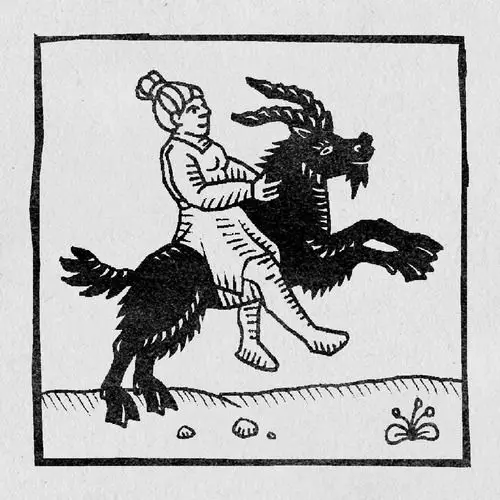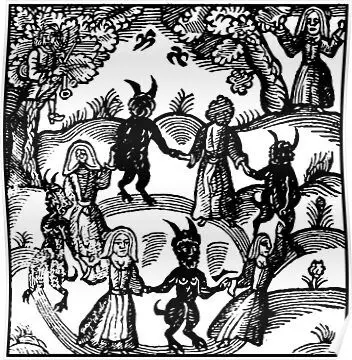In the middle of the XNUMXth century Johann Wier, doctor and demonologist, student of Cornelio Agrippa of Nettesheim, spoke out against the methods and doctrines of the Catholic Inquisition in defense of witches, through a thesis that combines scientific knowledge with occult ones in the wake of Agrippa and of Paracelsus.
di Mariachiara Valentini
The one of Johann Wier (1515-1588) is a figure as important as it is little known. Young pupil of that Agrippa author of By occulta philosophia, continued the master's studies in parallel with the official ones in medicine. It is precisely the union of esotericism, physiology and psychology that makes Wier such a peculiar scholar: we can describe his path as a perennial tension aimed at uniting the occult and the sciences. Wier detaches himself from Agrippa arguing that it is impossible to voluntarily change the work of nature, and therefore leaves no room for the practice of magic, but at the same time it is a demonologist who firmly believes in the existence of the Devil and in the exercise of his powers. The libellus fits into this perspective De latiis of 1577, a compendium of the third book of a larger treatise, the De praestigiis demonum et incantationibus ac veneficii (1563), in which Wier analyzes issues related to the action of demons and their influence on men; the aim of this re-edition is to reach a wider and less educated audience in order to spread their ideas about witches.
Wier's writings have aroused various reactions among his contemporaries: there is no lack of consensus but there are numerous harsh attacks by famous inquisitors, such as Bartolomeo Spina, which finally led to the inclusion of Wier's works in theIndex of prohibited books. And yet this has never translated into a real judicial proceeding, probably thanks to the prestigious position held by Wier, namely that of first doctor to Duke William III of Jülich-Clèves-Berg. Certainly among the most serious accusations is that of Jean Bodin, which in the appendix to his Démonomanie des sorciers in 1580 he explicitly accuses Wier of witchcraft and complicity with the devil. Wier, for his part, claimed that a witch
she is mostly a stupid old woman of mind, ignorant, illiterate, seduced by the demonic spirit that enchants her with its prodigies, invaded and corrupted by the devil but only with false thoughts and imaginations, so that she always comes to confess things that she would not have in reality never could do because nature does not allow it.

On the one hand, therefore, the man of science Wier considers it ridiculous even to suppose that such acts can actually be carried out, so far from reason and experience, but at the same time, as a believer, he does not deny, indeed confirms a real demonic influence on these weak subjects and in a certain sense already predisposed to be affected by modifications of the senses and of the mind. The inconsistency of the confessions torn under torture is also highlighted, the accounts of which are reported in Malleus Maleficarum: it is a curious manual of 1487, edited by the two Dominicans Heinrich Kramer and Jacob Sprenger in order to repress heresy and witchcraft in Germany, in which the modalities of the pact with the devil are described in detail.
In Malleus we read in fact that there are two different types of trade with the evil one: the first is "private", which can be carried out individually, while the second is ceremonial; it is the classic Sabbath of witches, in which the Devil usually appears in human form to give orders and impose the abjuration of the Christian faith on novices. In this regard, an interesting detail is described, on which Wier dwells at length: a certain one magical ointment, which spread on a wood allows you to fly, if drunk makes it immediately accomplices of the devil, if spread on the body it is able to modify and rejuvenate the features. It is obtained from cooking ("Until the meat, separated from the bones, does not liquefy") of baptized and non-baptized infants, and then carefully preserved - but, Wier objects, "if the graves that they [the witches] claim to have profaned are opened, the corpses will still be found lying and inviolate in those graves".
The true satanic suggestion lies precisely in the fact that someone can really believe in such wickedness, which go against the correct use of reason, and go so far as to argue "that the old woman has really carried out all the actions of which she is convinced to be the architect ". To this is added the possibility of rationally explaining this situation: just like in those affected by melancholy disease there is a strong alteration of the imaginative faculty, in the same way the phenomenon of "witches" can be ascribed to the onset of similar conditions. The hypothesis advanced by Wier is that the confessions of the witches under torture are indeed sincere, but provoked not by a real fulfillment of the admitted facts, but rather by hallucinatory states physiologically identifiable, and yet in any case caused by a direct intervention of the demonic powers:
Having obtained (always with God's consent) the faculty to produce such images and imprint them on living beings, the demons, through these forms, show fictitious appearances of beings who are now happy [...], now sad [...] and those sensations remain imprinted on them with the force of reality. […] And that is why such things only occur at night, because they occur during the dream; while during the day they only happen to people suffering from melancholic disease […] who suffer from hallucinations even when awake.

And who is it who, in dream visions, has never felt transported to the point of believing that they are in reality? Precisely in dreams, in ecstatic or hallucinatory states, the Devil snares, whose grip is strong on a sleeping conscience, and acts by means of persuasion in order to make it impossible to distinguish between reality and vision, so as to fully convince the subject that he has been conscious during the performance of those acts. If we add to this that the prototype of the witch is that of a person made weak by her seniority and her stupidity, we can easily understand how she is an all too easy prey for the Devil, who often also uses the help of "Certain natural preparations" with hallucinogenic properties.
Wier is aware that this theory of his which is partly scientific, partly metaphysical (in the sense that it lies beyond the merely physical explanation of things, and not in a strictly philosophical sense) may seem a mere reverie; for this reason he quotes a passage from Magiae naturalis sive de miraculis rerum naturaleum libri IV published by John Baptist Della Porta (1535-1615) in 1558: here an autobiographical episode is told, in which Della Porta manages to obtain a demonstration of her powers from a witch. After the woman had completely covered herself with the magical ointment she had prepared (based on baby fat, aconite, bat's blood and numerous aromatic herbs), she locked herself in a room and ordered Della Porta and his people to observe from the opening. of the door, but all they saw was the old woman asleep in a deep sleep, so much so that they were unable to awaken her until the ointment's effects were over; and when she finally woke up and began “making delusional speeches, saying […] things that obviously didn't happen”, firmly denying that they were hallucinations, Della Porta understood the properties of those natural preparations.
Witches are simply deceived by the devil, also with regard to their alleged powers over natural things, who deceives them that by means of certain rites they can cause effects that the Devil has already arranged, while by themselves "they could not even have brought about the fall than a drop of water ". A fortiori a "sane man" could ever believe that the natural course of things established by God can be so upset by the "futile operations of crazy women"? The fulcrum of the apology implemented by Wier lies in setting the image of the witch as that of an ignorant and stupid old woman, victim of the devil and unable to carry out those actions in total autonomy.

As regards the carnal conjunction of the witch with the devil, it is above all inconceivable such a relationship "between a spirit devoid of flesh and a mortal man": since a spirit does not possess and cannot possess genital organs, there is no " neither desire nor the possibility of coitus ”, since“ if the cause is missing, the effect is also missing ”. One can object to this thesis by resorting to the famous passage fromOld Testament (January 6,1: 8-XNUMX) where it is stated that
When men began to multiply on earth and daughters were born to them, the sons of God saw that the daughters of men were beautiful and took as many wives as they wanted. […] And these bore them children: these are the heroes of antiquity, famous men.
It is a difficult passage to interpret: up to the XNUMXth century AD it was used as a testimony of the angelic fault from which the demons arose; with the Fathers of the Church develops a more spiritual conception of the angels for which the "sons of God" are interpreted as the descendants of Set and the daughters of men as the descendants of Cain. And it is precisely on this difficulty that Wier rests, responding to the objection with the help of the patristic interpretation of this passage, which for him unequivocally refers to the lineage of Set.
Furthermore, in Malleus it is written that the Devil must first unite himself with a man and then with a woman, taking the semen from the man and placing it in the womb of the woman in the act of coitus in order to be able to conceive and generate a fetus - a fetus which, however, like many they recognize, he is not the son of the devil but of man succubated From it. This is simply ridiculous for Wier: not only the transport of the semen would cause the deterioration of the substance (while for Thomas Aquinas the Devil would have been shrewd enough to circumvent the physiological problems and succeed in his intent), but above all the human race itself would be already met with destruction if such horrifying creatures born of the union of women and demons were possible. Once again, therefore, we can attribute these stories to particularly intense hallucinatory states.

Wier's goal is to exonerate the witches of accusations because they do not exist from a rational point of view, considering that the same confessions are false and the fruit of imagination. The reference to the lycanthropy or the more generic animal metamorphosis becomes necessary: the absurdity of such a statement makes even the alleged actions carried out in an animal condition absurd, and it makes those wise men (or rather the inquisitors) mad who even for a moment believed that these facts could have really happened. And again with reference to the melancholy disease, Wier continues:
It is not difficult for the devil to drive a human being to madness, stimulating the suitable spirits, when it is a question of people whose brain is often invaded by the vapors of black bile; and there is a type of men prone to fascination and madness in this sense.
Yet, constantly "sensible men" do not hesitate to pronounce death sentences against these people, despite the mere hypothesis of such a transformation does not appear credible, hiding an inextinguishable thirst for blood behind their accusations. The second part of the De latiis it is in fact entirely dedicated to fallacy of witchcraft trials: The same tests used by inquisitors to prove that she is really a witch are experiments invented by the Devil that true Christians should fight. An example of this is the proof of water, according to which by immersing a witch in water with her hands and feet tied, she would float without difficulty. The first thing to do in the investigation of a trial for witchcraft is to check if the confessions find a concrete confirmation in reality, with the help of famous doctors, but unfortunately things do not go this way:
In these spell trials […] many things are emotional in nature […] and are distorted by malevolence and wickedness.
If we add to this the torture unspeakable to which the accused are subjected, a confession will be extracted by force of circumstances, and will be accepted by the minds of the judges who are already predisposed to see in them nothing but evil. Wier accuses the inquisitors of being "bloodthirsty in the highest degree" and of using drugs on the accused in order to extort such fanciful tales; and precisely in the use of drugs, the invalidity of the confession stands for Wier, as in a trial it is not possible to accept a confession made in an altered state of mind.

But the demonologist goes even deeper: being the so-called witches poor dull women, whose mind is clouded by the devil who uses them as mere passive tools, they are not dangerous for anyone (also because, as we have already noted, it is physically impossible that the events of which he accuses them may occur) and must be saved rather than burned at the stake. (In particular, Wier calls the stake a "sacrifice to Vulcan", as if with this pagan characterization he wanted to emphasize more that the true workers of the Devil are the inquisitors and judges). When the imaginary nature of the facts exposed by both the accusation and the witch is ascertained, the death penalty does not exist, and these women must be induced to repudiate the devil and take an oath of faith to Christ. The alternative to the execution proposed by Wier is a pecuniary penalty or, in the most serious cases, exile: it is impossible not to notice how this proposal is a great contradiction of Wier, who bases all his apology on some fundamental points between the state of extreme poverty of witches, to then propose a payment in money that these women could not dispose of, if they corresponded perfectly to the description of the De latiis.
If on the one hand we must recognize Wier's laudable intent, that is to save the lives of thousands of poor innocent people, we cannot avoid being hard on the assumptions on which the whole Wierian thesis is based. The description of the witches places us in front of a conception of the woman understood as a being weak “in mind and in nature”, of which the lamias are only an extreme case; yet it is essential that witches are stupid and easily manipulated, and that unlike wizards and sorcerers they are not capable of learning doctrines from books or masters as the impulse to search for the nature of things is non-existent in woman's nature: they “They cannot excel in anything peculiar, given the crassness of their mind and the incapacity of their spirit”, they are “senseless” beings.
It is easy to perfectly frame the concept of woman present in Wier's mind, and therefore to justify it for the foundations given to his thesis; the real weak point of the Wierian argument is the excessive presence of self-contradictions, and even the total absence of its fundamental presupposition: Wier is constantly ambiguous, he always lacks the support of a sure and total scientific explanation, and in some cases even doctrinal (such as for the carnal union between witches and the devil, in which he contradicts what is instead supported by the same demonological school from which he comes).
